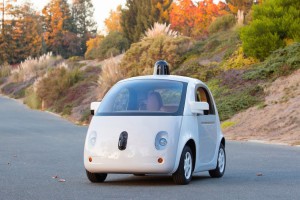
Google would like to find a partner to help it put the technology in this prototype into production.
Google is on a mission to change the world with its autonomous vehicle technology. But it doesn’t plan to launch its own carmaking division, instead hoping to find partners to work with, the tech giant’s automotive guru said.
There’ve been a lot of questions raised about Google’s plans since it revealed last year it was building 100 autonomous vehicle prototypes with the help of Roush, an automotive engineering and racing company based in suburban Detroit. The first of those are just beginning fleet tests around Google’s Silicon Valley headquarters.
But program director Chris Urmson stressed that, “We’re definitely not in the business of making cars,” during an appearance at the Automotive News World Congress, an industry confab in Detroit. Instead, he added, Google will be, be “looking for a partner to build entire vehicles….at some point.”
(American motorists want autonomous vehicles – and are willing to pay for it. Click Here for more.)
How soon self-driving vehicles will be ready for consumers remains a matter of debate, but it appears the industry will start with semi-autonomous systems, such as Cadillac’s SuperDrive. Capable of hands-free operation only on limited-access highways, it will be introduced on the new flagship CT6 sedan in 2017.
As for Google’s fully autonomous system, which will operate anywhere, any time, hands-free, Urmson said he hopes to have it ready by the time his son is old enough to drive, about seven years from now. And he’s recruited a number of suppliers with deep roots in Detroit’s auto industry, including Bosch, Roush, ZF and Continental, to help him.
(McLaren and partners showcase advanced digital cockpit. Click Here to check it out.)
Google’s various autonomous vehicle prototypes have now accumulated more than 700,000 miles of driving, including extensive tests on public roads. So far, there have been only three minor accidents.
“We’ve been rear-ended a couple of times and we’ve been sideswiped on the freeway,” noted Urmson, who has been involved with the development of autonomous vehicles for the more than a decade and helped General Motors develop a self-driving vehicle for a challenge run by the Defense Department.
“We’re very excited,” he said. “This technology has the potential to be tremendously transformative,” added Urmson. Many people do love to drive. But a lot don’t. What they want to do is get from one place to another,” he said.
Urmson also stressed that Google doesn’t need special permission to put its vehicles on public roads. “We think we’re a couple of years from a full scale test,” he said.
Since Google, isn’t following any kind of fixed business plan, the company’s objective is to make the technology invisible to the consumer. That’s where a conventional automotive partner would come in.
“It takes a lot of parts to build a car—especially a fully autonomous one,” he acknowledged. “To build our prototype, we worked with experienced automotive partners from around the world, and we couldn’t have come as far as we have without them. As we continue to develop our first fully self-driving vehicle, we look forward to working with these partners and others to bring this technology into the world safely.”
(Nissan, NASA partner on autonomous vehicle tech that could have applications on Earth and in space. Click Here for the full story.)
Duplicating what the average motorist does while driving is also exceedingly complex, the autonomous guru noted, and Google has had to come up with both the software and sensors that can detect and respond to lane closures, school bus stops, red-light runners and bicyclists.
Many of the basic sensors, using sonar, radar and cameras, already have begun appearing on today’s car. The most complex element is a laser device called LIDAR, that sits on top of the various Google prototypes to create a 3D view of the surrounding world.
“It’s not made of unobtanium,” noted Urmson. But it still costs $75,000 and the capacity to build them is very limited as production totaled around 150 units last year. But the price will drop significantly when volumes can jump to 150,000.
For their part, Google’s suppliers seem eager to work directly with the Silicon Valley powerhouse.
“We are in a very exciting time in terms of technologies that will result in smarter, safer vehicles. Roush has been honored to support Google in developing a vehicle platform to showcase their self-driving vehicle technology,” Roush said in statement issued after Urmson spoke.
Meanwhile, Samir Salman, CEO of Continental North America, said the Google car project was important step towards the goal of eliminating traffic fatalities.
Proponents of autonomous vehicles contend that the technology could virtually eliminate highway crashes, while also improving traffic flow and significantly reducing fuel consumption.
(Paul A. Eisenstein contributed to this report.)

You can bet if they ever get a finish design worked out the car will be built in China for cost savings. That should bring a lot of fear to consumers as the car will be 100% reliant on complex electronics for all operations. Consumer’s will be placing their lives in the hands of a computer… so there had better be not only failsafe designs, 100% accurate programming but also redundant systems in the event of any number of electronic sensors.